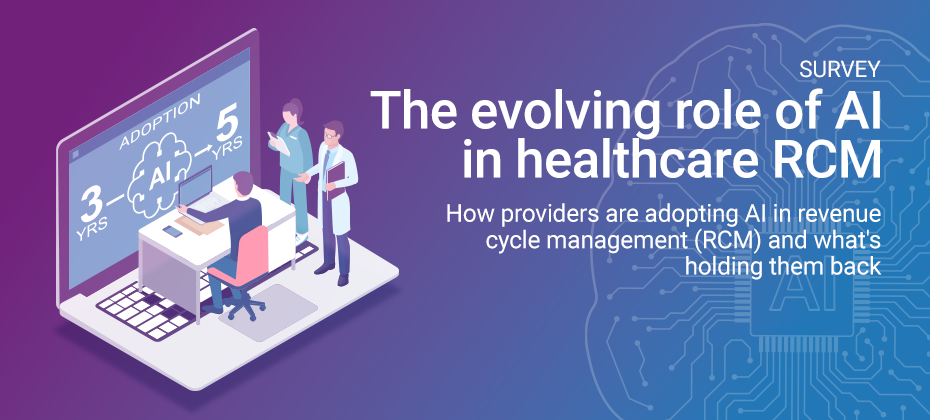Tag: patient access

Revenue cycle management (RCM) teams are facing a year of major change, with new regulations, tighter margins and the adoption of artificial intelligence (AI) increasing the pressure on workflows. This article outlines Experian Health’s five RCM predictions for 2026, along with tools to consider when building a resilient revenue cycle.

Hospitals that treat Medicaid patients should update their eligibility and billing systems now to prepare for the One Big Beautiful Bill Act (OBBBA), which will bring major changes to Medicaid.

Key takeaways: Providers see eligibility verification and patient access as top use cases, but are cautious about using AI for critical decision-making. Privacy, security, accuracy and cost are seen as the greatest barriers to AI adoption. Most providers expect AI use to keep growing, but agree that some level of human oversight will still be important. New statistics shared by Experian Health show that confidence in AI is growing steadily among healthcare providers, though many remain cautious about how and where it’s used. While 63% of providers have already introduced AI into their RCM workflows in some way, most reserve it for lower-risk tasks such as analysis and automation. Many are still testing the waters to see where AI can add value without compromising accuracy or security. Experian Health surveyed 200 healthcare decision-makers in October 2025 to gauge their feelings about AI. This article summarizes their views on AI adoption in healthcare, including the main barriers, top revenue cycle use cases, and predictions for the next few years. Infographic: The evolving role of AI in healthcare RCM While full trust in AI remains limited, especially for high-stakes decision-making, confidence is rising. How much do healthcare providers trust AI? Experian Health’s data suggests that providers are split between feeling confident about using AI and cautious about letting the technology make decisions on its own. Around four in ten survey respondents say they mostly or completely trust the technology. Three in ten describe their level of trust as moderate, while the remaining third say they trust it only slightly or not at all. These trust levels inform the type of tasks AI is used for. Most providers are comfortable using AI for automation and data analysis, but are hesitant to rely on it for higher-stakes decisions. Only 5% say they would trust AI to make critical decisions independently. Interestingly, hospitals appear to be more confident: half of this group say they mostly or completely trust AI, compared with 28% of other provider organizations. In a recent consultation response, the American Hospital Association stated that hospitals are already seeing AI make a “significant positive impact” in clinical care, noting that “AI tools hold tremendous potential in helping transform care delivery and address some of the administrative burdens that increase costs.” This experience may explain why they’re more comfortable moving ahead with AI in business operations, too. What are the biggest barriers to AI adoption in healthcare revenue cycle management? Concerns about data privacy and security are the top barrier to AI adoption, mentioned by half of the survey respondents. For 41%, accuracy is a sticking point, making it difficult to fully trust AI’s results. Although hospitals tend to be more confident in AI overall, their reasons for hesitating differ from other providers. Hospitals are more apprehensive about regulatory issues, with 26% listing this in their top three concerns compared with 21% of other organizations. On the flip side, they may have found more cost-effective ways to implement AI. Only 23% of hospitals see cost as a barrier compared with 39% of other providers. What areas of the revenue cycle would benefit most from AI? Catching errors early in the revenue cycle According to Experian Health’s data, providers think AI has its greatest impact at the front end of the revenue cycle. More than half (52%) put insurance eligibility and benefits verification in the top three opportunities. Patient scheduling and access follow at 45%, and 44% point to patient registration and data collection. Improving front-end processes is exactly what Patient Access Curator™ (PAC) is designed to do. Using AI and machine learning, it automatically verifies and updates patient insurance information with a single click. Improving data quality at this early stage reduces downstream errors and delays. Clarissa Riggins, Chief Product Officer at Experian Health, discussed the benefits of applying AI early in the revenue cycle in an interview with Medical Economics: “Much of [the denials burden] still comes down to friction in workflows and incomplete or inaccurate registration information at the point of entry,” she says. “Fix the problems at the start and that should address the claim situation toward the end.” Predicting and reducing denials Only 32% of survey respondents reported seeing claims submission and denial prevention as top opportunities for AI. This is somewhat surprising, given that 69% of those using AI reported seeing a reduction in denials and improved resubmission results, according to Experian Health’s State of Claims 2025 survey. This suggests there may be some untapped potential for AI in denial management. Tools like Experian Health's AI Advantage™ utilize advanced analytics and machine learning to identify denial risks earlier, predict outcomes more accurately, and recover revenue more efficiently, functioning as a complement to Patient Access Curator. See how AI Advantage predicts and prevents denials: How are healthcare organizations currently using AI? Currently, nearly two-thirds of providers say they are using AI in some way. Around 15% of providers have fully integrated it into their RCM operations. At the other end of the spectrum, 24% are still in the exploratory stages. For organizations that are not quite there yet, the following resources show the results that are possible: Case study: Experian Health & OhioHealth See how OhioHealth cut denials by 42% with Patient Access Curator by solving claim errors at the source. On-Demand webinar: Reimagining patient access Learn how AI and automation eliminate manual errors, reduce denials and unlock millions in recoverable revenue. How do providers see AI usage changing over the next few years? Most healthcare leaders expect AI adoption to keep growing over the next three to five years. For more than half, this comes with the caveat that human oversight will remain essential. A small number (6%) think progress could stall because of regulatory or trust issues. As adoption increases, providers will need to figure out the balance between autonomy and oversight. The most effective models will see AI and staff working together, with technology improving efficiency and giving teams more capacity to handle those complex, higher-stakes tasks. FAQs Where should healthcare organizations start if they are new to using AI in the revenue cycle? Clarissa Riggins recommends starting small by targeting specific processes where automation can make an immediate difference, such as eligibility verification or claim edits. Running an AI pilot in workflow is a good way to help teams build confidence in the technology and measure results before scaling up. Will AI replace staff in revenue cycle management? Experian Health’s data suggest providers see AI as a way to support, not replace, their teams. By taking on repetitive, data-heavy tasks, AI gives staff more time to focus on problem solving and higher-value work that requires human judgement. How can providers use AI responsibly while maintaining oversight? Successful adoption depends on clear governance, reliable data and staff-friendly interfaces. This means choosing tools that complement human decision-making and enhance oversight rather than remove it. Find out more about how Patient Access Curator and AI Advantage help providers use AI to drive stronger revenue cycle performance. Learn more Contact us

Manual insurance eligibility checks are slow, error-prone and a leading cause of claim denials. Find out how automated insurance verification delivers real-time accuracy, fewer billing errors and faster reimbursements — helping providers protect revenue and improve patient care.

Experian Health’s 2025 High-Performance Summit was a catalyst for collaboration, innovation and a shared commitment to simplifying healthcare – for both providers and the patients that they serve.

When it comes to artificial intelligence (AI) usage in the healthcare industry, adoption is steadily gaining momentum as providers explore new ways to utilize this technology in their revenue cycle management (RCM) processes. While full trust in AI remains limited, especially for high-stakes decision-making, confidence is rising. Privacy, security, and implementation costs continue to pose significant challenges. However, providers broadly agree that AI will become a cornerstone of healthcare RCM in the next few years, especially in areas like eligibility verification and patient access. Many also acknowledge that human oversight will remain essential, to ensure accuracy and trust. In October 2025, Experian Health surveyed 200 healthcare leaders to better understand how much they trust AI for decision-making, their biggest barriers to adoption, and where the opportunities lie. Here are the results: AI in healthcare RCM isn’t the future; it’s happening now. Learn how healthcare organizations are using Experian Health’s AI technology to streamline patient access and reduce claim denials. Learn more Contact us

In this guide to healthcare revenue cycle management, learn how healthcare organizations can optimize the revenue cycle process at every stage of the patient journey to increase reimbursements and improve operational efficiency.

AI and automation are transforming the claims management process. By streamlining workflows and minimizing errors, these technologies can help providers reduce denials, enhance operational efficiency and improve patient access to care.

AI is reshaping patient access by reducing manual errors and preventing costly claim denials. Tools driven by AI and automation can streamline eligibility checks and coordination of benefits — helping providers improve efficiency, cut costs, and deliver a better patient experience.